
How to build smarter products: A guide to intelligent IoT and embedded system development
In today's hyper-connected world, building a smart product is no longer just about placing a sensor on a device and connecting it to the internet. True smart product development requires a thoughtful, systematic approach—one that spans hardware, software, connectivity, and continuous performance monitoring.
Whether you're creating a medical wearable, a logistics tracking system, or an industrial IoT device, the journey from idea to market—and beyond—can be complex. In this article, we’ll explore how modern companies are tackling this challenge using structured development models, AI-powered optimization, and long-term support strategies. We’ll also show how development partners like needCode play a critical role in enabling this process.
From Concept to Connected Reality: What Smart Product Development Really Means
Creating an intelligent product is more than just engineering—it’s about solving real-world problems with scalable, reliable technology. This is why experienced software development partners adopt a structured, four-phase approach:
Development partners like needCode bring a comprehensive skill set to each of these phases—including embedded, mobile, and web software development; hardware prototyping; backend infrastructure; and regulatory compliance.
Smarter Doesn’t End at Launch: The Role of Optimization
Here’s something many teams overlook: smart products need to evolve. Once deployed, a connected device operates in dynamic environments. Conditions change. Loads fluctuate. Networks behave unpredictably. This is where Smart Product Optimization becomes critical.
Partners like needCode approach optimization with a data-driven mindset, focusing on four key pillars:
Why It Matters
For companies building products in healthcare, logistics, manufacturing, or smart cities, the stakes are high. Downtime can be costly. Regulatory compliance is non-negotiable. Customer expectations are sky-high.
Working with a development partner that not only understands how to build smart products but also how to optimize them after deployment can make the difference between a failed pilot and a scalable success story.
Services like those offered by needCode are designed for exactly this: to support businesses at every stage of the smart product lifecycle, from initial concept through to long-term performance excellence.




